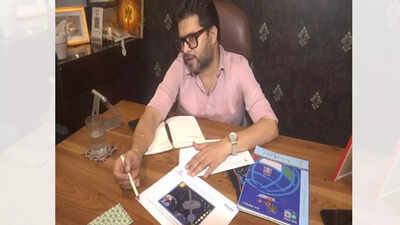
India’s growing ambitions in space will soon be represented not just through technological feats, but also a powerful symbol of cultural pride. As Group Captain Subhanshu Shukla prepares for his journey aboard the
Axiom-4 mission
to the International Space Station, he will wear a specially designed mission badge crafted by Indian designer Manish Tripathi. This emblem serves as more than just mission insignia that fuses India’s deep-rooted scientific legacy with its rich cultural heritage. From the symbolism of ancient observatories to nods at modern achievements like Gaganyaan, the badge tells the story of a nation rising in space exploration. It’s a historic moment where tradition meets technology; India’s identity stitched into the stars, and carried proudly on the global stage.
Indian designer Manish Tripathi creates mission badge for Axiom-4 astronaut Shubhanshu Shukla
What is exceptional about this badge is the personal relationship between the designer and the astronaut. According to ANI reports, classmates Manish Tripathi and Shubhanshu Shukla share a past, and out of this, they led a partnership founded on vision and trust. The two shared ideas back and forth for eight months that bridged time zones to ensure that the badge would be an honest and truthful portrayal of India's space journey.This was not a regular design assignment. It required technical sophistication, cultural sensitivity, and a purpose. Every aspect of the design had to be prototested for its usability in space-grade materials and conditions. This makes it a graphic narrative of India's story through symbolic design. The badge is more than just an eyesore sight loaded with symbolism of varied layers. Similar to the shape of a postage stamp, the symbol indicates India stamping a message to the world.
What each element of the Axiom-4 emblem says about India’s space legacy
Here's what the most vital elements are and what they mean:
- Gaganyaan icon: A reference to India's maiden human spaceflight mission, a new gold standard for indigenous space exploration.
- Aryabhata satellite: 50 years since the launch of India's first satellite, a milestone in the national scientific history of India.
- The Sun: A heavenly body which is worshipped in Indian culture and one which is central to space science too, symbolizing energy, continuity, and light.
- Jantar Mantar observatory: A reference to the ancient Indian wisdom on astronomy and ancient curiosity about the universe.
- The infinity symbol and the zero sign: Both mathematical symbols were created for the first time in India and form the cornerstone of ancient science and space travel.
- The Moon: In terms of ISRO's successful moon missions like Chandrayaan-2 and Chandrayaan-3 that made India a global leader in space technology.
- India's map in the chin of an astronaut helmet: This design is a tribute to the valor of Lord Hanuman symbolising the country being propelled forward with courage and intention.
All these were carefully picked to demonstrate that India's identity in space is not only new and intentional but also historical and philosophical.
NASA’s Axiom-4 mission features India’s cultural emblem in space
The badge includes flags or maps of countries working together on the Axiom-4 mission, representing world cooperation symbolically. This serves to highlight that space is a global effort, and India is no longer at the fringes; it is a dynamic, active participant.India's partnership with
Axiom Space
, NASA, and SpaceX on missions like Axiom-4 is an indicator of its transition from being an emerging space nation to a global player in becoming a part of the shaping of the future of orbital technology and science. Tripathi emphasised that the badge will be an inspiration for future generations. He calls it "India's fingerprint in space," not merely a badge of national pride, but an incentive to think big. It is an emblem of Indian excellence on a material level, reminding students, innovators, and citizens that they can make a difference on earth or even in outer space.
Shubhanshu Shukla represents India’s strength and spirit on Axiom-4
Group Captain Shubhanshu Shukla is more than a guest to Axiom-4; he's a symbol of Indian grit, intellect, and humility. Tripathi referred to him as "a real superhero"; a vote of confidence for his level head and seriousness of purpose he represents. Shukla dons his suit with this emblem bearing the aspirations of over a billion citizens.The Axiom-4 mission in itself is a component of the wider trend in the space sector towards private-public partnership. With NASA in alliance with Axiom Space, and SpaceX, such missions are establishing the next generation of space station, deep-space logistics, and low-Earth orbit research capability. For India, participation in such missions is about more than representation but it is actually about redefining what Indian innovation looks like on a global scale. With the inclusion of Tripathi’s emblem, India asserts that science and culture, ambition and tradition, can move forward together.Also Read | NASA launching rockets to investigate mysterious ionospheric clouds disrupting global communication networks

 9 hours ago
46
9 hours ago
46




























 English (US)
English (US)